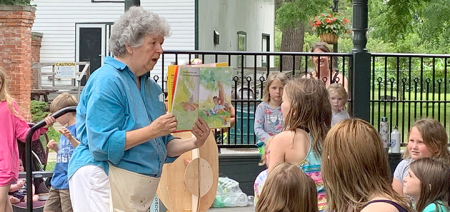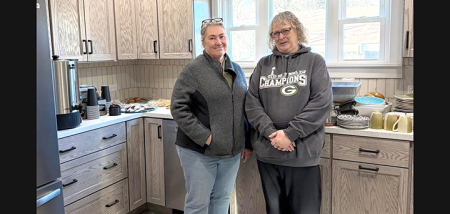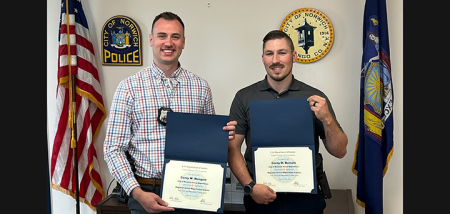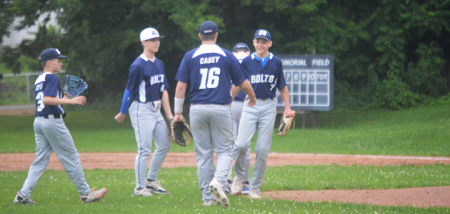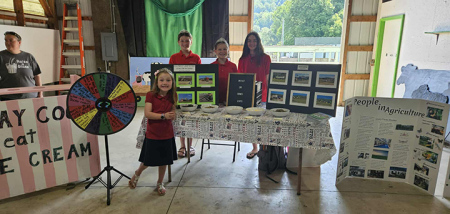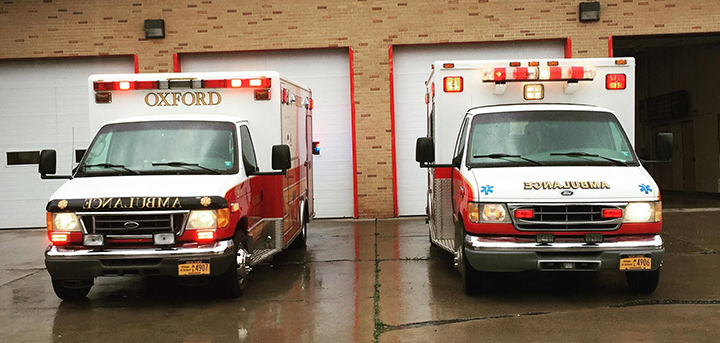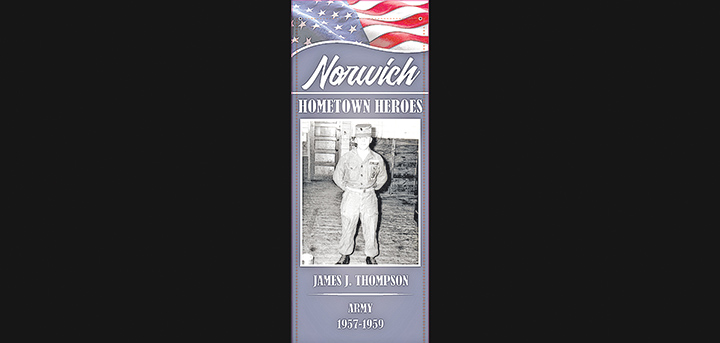NHS Sports Hall Of Fame: Roger Shonosky; Class Of 1972
Published:
August 5th, 2016
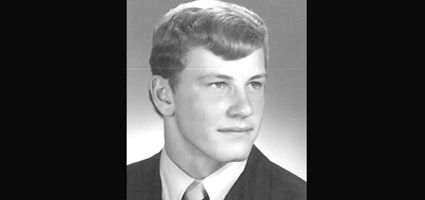
Sports Editor's Note: The following was submitted by Norwich High School Athletic Director Joseph Downey, and was written by Tom Rowe.
When legendary television producer Norman Lear’s “All in the Family” premiered on CBS on Jan. 12, 1971, little did he realize that the title of the iconic, satirical sitcom was a perfect description of the athletic talents embodied in the Shonosky household. Headed by former Lebanon Valley College standout athletes Walt and Jean Shonosky, their surname was commonplace throughout Norwich sports arenas that January of long ago, thanks to the exploits of their son Roger.
Having just completed his first Tornado varsity season as a starter with the culmination of the 1970 football schedule, Roger was in the throes of the Purple cage campaign when that immortal television show was first aired. By the time his Norwich career was over, he had earned seven varsity letters – three in baseball and two each in football and basketball – as he was the consummate three-sport athlete, thus resulting in his induction into the sixth edition of the Norwich High School Sports Hall of Fame.
Trying to determine which sport was Shonosky’s best will be left to the crystal ball gazers as he excelled in all three. During his two autumns on the gridiron Norwich was a collective 10-5-1 (.667), as a two-year member of the basketball team the Tornado went 26-14 (.650) and after three springs the Purple baseball nine showcased a 40-19-1 (.678) log. That cumulative success warrants why he was presented with the annual Judge David F. Lee Award, signifying the Outstanding Senior Athlete, at the 1972 Honors Assembly.
As was noted earlier, those achievements were mirrored years before by his parents, both 1952 graduates of Lebanon Valley. His mother, who hailed from Pemberton, PA (a small hamlet 14 miles northeast of Altoona) when she was Jean Hutchinson, was a standout basketball and field hockey player, subsequently being LVC’s first female athlete inducted into the college’s Athletic Hall of Fame in 1982. Walt, who was a star fullback at Union-Endicott, was a three-year starter as a running back on The Flying Dutchman’s football team. While helping lead LVC to a 7-3 log during his senior year of 1951, he was described as “our bruising, hard-hitting football hero” in the college newspaper. Thus, the lineage was born.
To examine Shonosky’s prowess in his three-sport endeavors, let’s start alphabetically with baseball. There, as we noted earlier, he earned three varsity letters. As the Tornado’s on-field manager from his catching position during his junior and senior seasons, he batted .314 (22-for-70) and .389 (21-for-54), respectively, while his sophomore campaign was spent mainly as a defensive replacement in the outfield.
Playing a tough independent schedule, which showcased a doubleheader sweep of Section III powerhouse North Syracuse (9-0 and 13-5) in which Shonosky was 3-for-7 with two runs scored, during his senior year of 1972; Norwich compiled a 12-5-1 mark, with four of those losses coming by only five runs. Shonosky, the Purple’s every-day catcher, not only called the scenario for all games, but contributed 16 RBI and 12 runs scored with the actual total of those stats probably higher if numbers were more accurately tabulated at the time. Hitting safely in 14 of those 18 diamond contests, he went 3-for-4 with a three-run homer, RBI-single and run scored in an 8-1 victory over Oxford, was a perfect 3-for-3 with two RBI and a run scored in an 8-3 triumph over Bainbridge-Guilford and blasted a 340-foot RBI-double off the top of the fence in going 1-for-2 with a run scored in a 5-1 win versus Homer.
“Roger was an exceptional athlete from our beginnings together in Little League. He was supremely confident in his abilities even in those days,” noted his long-time NHS battery mate and fellow class member Dave Martin. “Roger was clearly built to be a great catcher. He was a strong hitter and was a solid defender with a cocky arm.”
During Shonosky’s junior season, the last one in the Iroquois League, Norwich compiled an overall log of 14-8 and a league mark of 8-6. As an honorable mention selection to the all-league team, he batted that aforementioned .314, with high-water marks coming in a 25-8 thumping of Rome Catholic and a 6-5 loss to Mohawk. Against Rome he was a lethal 5-for-7 with four RBI and four runs scored, while versus Mohawk he chalked up a triple, double and single in four at-bats, resulting in two runs scored and an RBI. All told that spring, he compiled 16 runs scored and nine RBI.
“Roger had instinctive ability and physical strength, which when combined with supreme self-confidence enabled him to be one of the finest athletes ever in Norwich,” said Martin, who teamed with Shonosky from Little League through high school, as well as sophomore members on the Norwich nine in the Southern Tier Men’s Baseball League. “In Little League he was one of the first I ever saw pull the fake passed ball play, and that was typical of the self-assured nature that Roger played all sports with well into the future.”
His self-assuredness may have been most manifest during his two-year tenure on the Tornado’s hardwoods. Over that span of 40 games, Shonosky tallied 582 points (14.6 ave.) – 345 (16.4 ppg.) during his senior season and 237 (12.5 ppg.) as a junior. Those 582 markers represent the 28th best in Norwich scoring history and third best of the 1970's – behind only Tim Whitney (947) and Gary Stewart (827). And, at the time of his graduation were 11th all-time.
“I believe Roger would agree that basketball was the third sport for him, because I think he was better at football and baseball,” noted John “Pencil” Swertfager, who teamed with him on the courts for those two seasons. “But make no mistake about it; Roger was a very good to great basketball player.”
Obviously others agreed as Shonosky, who was dubbed “Mr. Clutch” during his hardwood days, was voted the team’s Most Valuable Player both his junior and senior seasons. He also gained first- and second-team All-County status those respective years as the Tornado sported records of 13-8 and 13-6 during independent and Iroquois League activity. That latter mark was second only to Section III champion Oneonta in 1971.
“Roger led in every important category and also led all of his teammates by a wide margin in coach (Bill) Carson’s ‘plus-minus’ system,” explained Swertfager. “Roger was not a good practice player and didn’t like to practice. But in games, oh my goodness! He became faster, quicker, stronger and jumped higher when it mattered. He had a knack for doing the right thing on the court very consistently.”
And consistent he was as he reached double-digit scoring in 28 of the 40 games he started for a 70 percent success rate. As a senior he tickled the twines for those double digits on 15 occasions, with six of those outings resulting in 24 points or more. His season- and career-high of 32 came in a 78-68 triumph at Canastota on Jan. 22, 1972, when he also pulled a career-best 18 rebounds; another 17 occurred on two other endeavors. While a junior, he carded 10 points or more 13 times, with back-to-back totals of 20 each coming in respective victories at home versus Mohawk (66-39) and at Rome Catholic (72-64) on Jan. 28 and Feb. 5, 1971.
“I first saw Roger when we were in fifth or sixth grade. Perry Browne, Gibson and St. Paul’s played each other on Saturday mornings. I didn’t know much about basketball then, but you could already see he was one of the best players in the three schools,” recalled Swertfager. “One thing he would later do all the time was step out of bounds and then back in bounds to get in front of an opponent who was boxing him off the boards. It was against the rules, but he got away with it quite a bit.”
While Swertfager opined that Shonosky’s third-best sport was basketball, despite capturing two straight team MVP awards, the debate grew even greater when trying to compare his offensive and defensive abilities on the gridiron. Taking over at quarterback in NHS’ third game of the 1970 campaign, he threw for 19 touchdowns and 1,349 yards, rushed for three more scores and produced 26 extra points – 22 on the accuracy of his arm and the other four on the strength of his legs – before his 13-game career was over. If those gaudy offensive numbers weren’t great enough, he also tabulated 21 interceptions from his free safety position.
“He always seemed to be in the right position at the right time,” chimed then Oneonta head coach Ed Pushkar, whose team was on the losing end of a 38-14 score on Nov. 7, 1970. That victory completed a 7-0 undefeated Iroquois League season that resulted in Norwich’s first outright league title since the loop’s inception back in 1953. The Tornado shared the crown with Frankfort and Oneonta in 1965 and with Oneonta again in 1966.
Shonosky, who teamed with Eddie George on a 20-yard scoring strike via a fourth-and-8 rollout play, put the final nail in the Purple’s victory when he picked off an errant spiral from Yellowjacket signal caller John Bertuzzi in the game’s waning moments.
“It was a fitting finale to a typical game performance,” reported Evening Sun writer Dave Thorpe. “Shonosky intercepted the only long Oneonta aerial with all the aplomb of a baseball center fielder gathering in a lazy fly ball.”
That fitting finale had its glorious beginning on Oct. 3 when Shonosky stood behind center for the first time in a lopsided triumph at Mohawk. There he completed 8 of 12 passes for 143 yards, threw for a two-point conversion and hooked up with Ron Swingle on a pair of touchdowns from 25 and 53 yards.
Once again Thorpe wrote, “Substitute junior quarterback Rog Shonosky, a talented free safety, was equally devastating as a passer as the Purple Tornado shackled Mohawk 36-6 Saturday.”
In between this initial success and that league-clinching victory versus Oneonta, Shonosky eclipsed the 100-yard passing plateau in three of his other four outings – 111 and 108 yards in Alumni Field victories against Rome Catholic (56-0) and Frankfort (28-0) and 109 yards at Herkimer (22-12).
His six-game resume for the fall of 1970 reads 46-for-80 for 576 yards, 10 passing touchdowns, one rushing TD and 16 PATs (12 by air; four by ground). Of Norwich’s 208 points scored, Shonosky was responsible for 82 (39 percent) either by his arm or his legs. He also picked off opposing quarterbacks 13 times, while throwing only three interceptions, himself.
“Roger was an outstanding offensive and defensive football player,” praised former NHS head coach Norm Kaufman, who led the Tornado for three seasons from 1970-1972. “At quarterback, he was both a passing and running threat, with a strong arm, great size and speed. And as a free safety, he was a relentless tackler, physically tough and highly competitive.”
Norwich’s only loss of 1970 was a 6-2 heartbreaker to Utica Free Academy in the season’s lidlifter. That defeat was summarily dealt with in the 1971 opener when the Tornado inaugurated its difficult independent campaign with a 52-8 thrashing of UFA at Alumni Field. There, Shonosky threw for a career-best 230 yards and three touchdowns, while running in another from five yards out. In completing 10 of his 22 attempts, he found Brian Leahy on a 9-yard score, Denny Mirabito from 15 yards away and George on a 17-yard caper.
The Tornado added decisive wins against Binghamton Central (30-18) and Oswego (61-0), but a pair of close defeats to Section IX powerhouse Middletown (13-6) and archrival Oneonta (12-6), and a frustrating 0-0 tie at Fulton left the Purple a game below .500. Still Shonosky rang up 773 yards of aerial real estate as 49 of his 104 tries found their mark. Throwing for nine touchdowns and 10 PATs, he rushed for another two TDs as he accounted for 42 percent (76) of the Purple’s 183 points. And, once again, he was a defensive whiz, intercepting eight opponent passes.
Although he topped the 100-yard passing mark in 8 of his 13 starts, Shonosky gained all-star status as a free safety, a position he won All-County accolades both years running with his career 21 interceptions. At the outset of his senior season, he was selected as one of the Top 100 defensive backs in the nation by “Kickoff Magazine.”
That recognition ultimately led to a football scholarship to the University of North Carolina in Chapel Hill. The Carolina Press Blue Book in its 1976 pre-season articles said, “…other Carolina players who figure to be strong contenders for All-ACC honors include nose guard Roger Shonosky.” From that position, he led the Atlantic Coast Conference in tackles, before a serious knee injury ended his career.
Today, instead of breaking down gridiron offenses by wreaking havoc with his punishing tackles and uncanny ability to pilfer passes, Shonosky is busy building the community as an accomplished home construction contractor. What remains is the debate as to which sport was his most proficient all those years ago when he left us with indelible memories on all three fronts.
Swertfager, who witnessed many as a teammate and a fellow classmate, has one particular basketball favorite. “Little Falls and Rome Catholic were favored to win the Iroquois League our junior year (1970-71). Our first game with Little Falls was there and it was close the entire way, eventually going to overtime,” recalled Swertfager. “I’ve been watching basketball for 50 years and Roger would make two of the greatest all-time plays I’ve ever seen. With seven seconds left in the first overtime, Roger took the inbounds pass, drove through three defenders before going between two more to score the tying basket (70-70). He wasn’t done yet, though. With six seconds left in the second overtime, Roger again took the ball the length of the floor and scored the tying basket (74-74), going through three opponents. Even our coach Bill Carson, not known for public hyperbole was quoted as saying, ‘It was a great play’.”
By the way, Shonosky wound up with 18 points as Norwich prevailed 84-80 in four overtimes on that cold Saturday night, Jan. 2. Even Archie and Edith, who were still 10 days away from becoming household names would have agreed, “Those Were the Days!”
Comments
